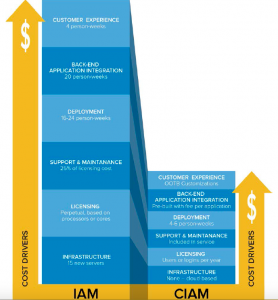Anyone who has sold professional services knows how complex the business development process can be. The cost of services like yours can be high, so most buyers can’t afford to choose the wrong firm. And your prospect may have more than money at stake—their professional reputation may be on the line.
In short, today’s buyers have plenty to worry about. Conducting prospect research can help you alleviate their concerns.
When the stakes are high, it helps to learn as much as possible about a prospective client before you get on the phone with them. The more you know about a prospect’s business, industry and role, the greater your chances of building an emotional bridge with them—and the easier it will be for them to trust you.
Researching your prospects doesn’t have to be difficult, and it can be done at a variety of levels. In this post, we’ll explore your research options and recommend specific techniques and tools you can use to develop business more effectively.
What Is Prospect Research and Why Is it so Important?
Prospect research is used to identify, evaluate and gain insight into individual prospects or market segments with the goal of developing new client relationships. It typically involves using multiple secondary research techniques to qualify, nurture and close new prospects.
Conducting this kind of research offers seven key advantages:
- Saves time and effort: Because prospect research can qualify prospects up front, you can focus on the most promising opportunities. You’ll waste a lot less time with unqualified prospects.
- Shows that you understand their issues: Research can also enhance your credibility during a prospect call or meeting. When a prospect realizes you already understand their challenges, they are more inclined to trust your expertise.
- Demonstrates familiarity with their industry: Most buyers are looking for past experience and are not eager to pay for your education. Research can arm you with relevant information on their industry and competitors.
- Indicates that you’ve done your homework: When you’ve done even a basic level of research into a potential buyer, it signals that you cared enough about them to put in the extra effort. You’ll earn their respect.
- Fills embarrassing gaps in your knowledge: When you know nothing about a prospect, it is easy to say something awkward or inappropriate. In some cases, you can’t recover from these gaffs. There is such a thing as a stupid question. It’s one you should already know the answer to.
- Builds trust: When it becomes clear to a prospect that you can talk intelligently about their problem, understand their business and can solve their problems, they are far more likely to trust you.
- Helps you close business: Research equips you with the inside knowledge and trust it takes to tip the scale in your favor.
Who and When Should You Research?
Researching prospects may sound like a daunting task, but it doesn’t have to be. Generally, it happens on three levels, which we describe below. Even cursory research may include all three levels, but you’ll have to rely on your judgement to decide if you should focus more of your time on a particular area. Not all prospects are going to require the same amount of effort.
Level 1: Researching an Individual
Whether you are responding to a referral, an individual who has reached out through a web form, or any other situation in which you are about to speak to a new business prospect for the first time, consider doing some research on their background before you pick up the phone. The more informed you are up front, the smarter you will sound—and the more likely you are to impress the person on the other end.
Is it worth doing this kind of research? And how much time should you invest in it? The answer to those two questions will depend on a number of factors, including how soon you need to make the call (or in-person visit), how busy you are and how promising the prospect appears to be.
Most often, you’ll probably only have time for a quick-and-dirty background review (see If You Only Have a Few Minutes below). That’s perfectly fine. At least you won’t embarrass yourself. But when you have time—especially if the prospect appears to fit your ideal prospect profile—try digging a little deeper. (We’ll explain how a bit later in this article.) When prospects are nodding their heads as you speak and think to themselves “yeah, you really get us,” you have won most of the battle.
You may find yourself fighting the urge to “just wing it.” It’s all too easy to convince yourself that you don’t have the time to spend on this sort of investigation. Anytime you notice your mind wandering in this direction, think of the possible consequences. You see, it’s also all too easy to expose your ignorance, ask a foolish question or underwhelm a prospect who was expecting you to be better prepared. How much will a few minutes of research cost you? Not as much as the alternative. You can bet on it.
Level 2: Researching a Firm
In most B2B and professional services situations you will not only be interested in the individuals you will be engaging with, but also their firm. Both are very important to understanding context and setting yourself up for success.
Research can also be valuable when you are building or vetting a list of prospects. Usually this involves identifying potential candidates and determining whether they might make viable clients by comparing them against a list of qualifying criteria.
Typically, you begin with a list of companies that you want to target, but you often don’t know many relevant details, such as the firm size or names of the key players. Prospect research uncovers the details—names, titles, business functions, biographical information, financial information and more—that allow you to reach out and engage these businesses in a way that’s more relevant and personal. Whether you are compiling a list from scratch or culling an existing prospect list to identify the best targets, research is the tool you need to make well-informed decisions.
Level 3: Researching an Industry
If you plan to reach out to multiple prospects in an industry you know relatively little about, you will improve your chances of impressing them if you can demonstrate at least a basic understanding of their business challenges and environment. You’ll want to learn about industry trends, challenges and priorities, as well as what issues these businesses are wrestling with today. You may also want to determine how your firm is perceived in that industry, and how best to turn these prospects into clients.
How to Conduct Prospect Research
In most professional services and B2B situations, you’ll want to explore all three levels of research described above. For example, if you get a referral from an existing client, you’ll probably want to learn about the individual, their firm and their industry. Let’s look at the kind of information you should be seeking at each level.
Individual Level
- Name and role in the organization
- Years with this firm
- Prior positions and roles
- Educational history
- Work history and experience
- Areas of professional expertise
- Notable publications/presentations
- Notable awards or accomplishments
- Possible points of connection (e.g., went to the same school, you know some people in common)
- Role in current or potential opportunity (e.g., decision maker, end user, etc.)
- Reporting relationships (if you are meeting with multiple people in a prospect’s organization)
Firm Level
- Industry
- Product/service offerings
- Firm revenue
- Financial performance
- Number of employees
- Firm history
- Leadership and organizational units
- Legal issues
- Press coverage
- Issues facing the firm and its industry (see Industry Level below)
- Roles related to your services
- People in the relevant roles (see Individual Level above)
Industry Level
- Industry size and anticipated growth
- Industry economics
- Number and type of firms in industry
- Key industry players
- Legal and regulatory issues facing the industry
- Marketplace issues facing the industry
- Your key competitors who are active in the industry
- Key competitors’ reputation in the industry
- Key competitors’ visibility in the industry
- Your firm’s reputation in the industry
- Your firm’s visibility in the industry
- Your firm’s competitive advantage or disadvantage
Top Prospect Research Tools
In many situations, prospect research should be efficient and relatively easy. We’re not talking statistical analysis and multivariate regressions. This is basic information gathering—done quickly and using a variety of light-weight tools.
In other situations, more formal research may be in order. For example, your firm may be contemplating entering a new market or trying to decide which industries to specialize in. In these cases, it may make sense to invest in a professionally conducted industry level study. This will allow you to investigate some of the important, but hard-to-research questions such as your firm’s reputation and visibility or how you compare to key competitors.
Individual Level
- Bio on firm website
- Web search (e.g., Google, Bing)
- Other social media (e.g., Facebook, Twitter)
- Internal records(e.g., CRM, marketing automation system)
Firm Level
- Firm website
- LinkedIn company page
- SEC filings (public companies)
- Analysts reports (public companies)
- Press releases
- Web search
- Customer review sites (e.g., G2Crowd, Better Business Bureau, Yelp)
- Trade publications
- Local/regional business publications
- Industry directory listings
- Employer review sites (e.g., Indeed, Glassdoor, Comparably)
- Proprietary databases (e.g., D&B Hoover, ZoomInfo/DiscoverOrg)
- Internal records (e.g., CRM, marketing automation system)
Industry Level
- Analysts reports
- Proprietary databases
- SEC filings (public companies)
- Trade publications
- Web searches
- Association websites
- Census data
- Original research studies
What Research Tools Should You Use?
There is no end of research tools out there. And if you are looking for specialized information (financial information, web metrics, etc.), you may seek out dedicated tools. But we’re not going to address those outliers in this article. Instead, let’s explore the (mostly free) tools used most often to conduct general research on professional services business prospects.
The Firm’s Website
A prospect’s firm website is the first place you should turn to learn about its business and people. Here are just some things you may be able to learn:
- What they do
- What industries they serve
- Who their clients are
- What they specialize in
- Who their leaders are and details about their backgrounds
- What they write and speak about
- How big they are (number of people, number of offices)
- What awards they’ve won
- Financial statements and annual reports (if they are a public company)
If the site has a blog, check it out. You might learn something about the issues that they care about. Does your contact at the company write blog posts? Read a few of them. Also take a look at their news section to see if anything of note has taken place recently. Look out for changes in leadership, new products or services, recent acquisitions, significant new clients or contracts—and the like.
This is probably the best place to learn about an individual prospect. Here’s what you want to look for:
- What responsibilities they’ve had at their current job
- How long they’ve been at their employer, and how they have advanced in the company
- Past job experience. Are they likely to have bought services like yours before?
- Do they share any connections with you? Is there anyone you might want to mention during your meeting?
- What groups they belong to
- What are they writing about and sharing?
- Where did they go to school?
And don’t forget to check out the company’s LinkedIn page, too. It often presents the company in a slightly different way than their website.
If you know your prospect’s Twitter handle, take a look at their page and see what they’ve been writing and sharing. Also see who they follow. Look for trends in their interests. Next, look at the company’s Twitter page to see how they talk about themselves and what they’ve been promoting.
Look for any relevant interests or personal information that you might be able to use during your conversation. Just don’t be creepy. People don’t want to feel like they have been spied on. Think of Facebook as a place to get a general feel for the person, rather than a source of actionable information. If you happen to find something very relevant, be careful how you introduce it in your conversation.
CRM and Marketing Automation Systems
Your prospect may have a history of interactions with your firm, already. Check your internal marketing and customer relations platforms to see what records they contain on this prospect. They may have downloaded content or reached out before to one of your colleagues. That’s useful information as you go into a call.
Search for both the individual prospect and their company and see what turns up. Look out for news stories, online reviews, partnerships, awards and any other potentially relevant personal and professional details.
Glassdoor
While you always should approach employee reviews with caution, they can sometimes surface useful information about internal and external challenges, as well as structural changes that won’t appear in official company news.
Local and National Business Lists
Private companies are not required to release financial and other information to the public. But to appear in certain prestigious “top” lists, they often have to do so. Check out the Inc 5000, your local Business Journal’s top lists by industry, and other lists of fastest-growing or largest companies. Many trade associations also publish lists like these.
Financial Statements and Annual Reports
If your prospect works for a publicly traded company, be sure to look at recent financial statements and the company’s annual report. You can learn a lot about their financial performance, strategic direction and recent challenges.
If You Only Have a Few Minutes
Sometimes you don’t have time to do research the right way. And that’s perfectly okay. Doing some research—even if it’s quick—is almost always better than doing none. When time is of the essence, here’s what I would suggest you do:
First stop is the firm’s website. This can give you a quick overview of where the individual works. Check out the About section for an overview of the firm, special expertise and areas of focus. Take a look at their products and services pages, as well any pages that describe the industries they serve. Read your client contact’s bio page, as well those of any other people in the firm you expect to meet. You’ll learn about their role in the company and perhaps see what they’ve published. You may even pick up some useful tidbits about their personal and professional interests.
Next stop is LinkedIn. Here you can learn more about the individual’s background, including prior positions, education, mutual contacts, publications, speaking engagements and more. Then hop over to their LinkedIn company page. This may fill in details that the website omitted, such as the estimated number of employees.
Last stop is Google. Here you can search on the firm and do a quick scan for any relevant press stories, reviews and publications. Look for significant legal or public image issues, as well as profiles and reviews relevant to your services. Also, do a search on your contact. You may find out about significant outside interests and hobbies.
Done. Now have your meeting.
A Final Thought
Prospect research is one of the keys to successful business development for professional services firms. Even a few minutes of effort can avoid relationship-killing embarrassments and add to the insights you can offer. And if you have time to conduct more systematic research, you’ll uncover new opportunities and avoid costly missteps. These are investments that offer rich returns and reduce your risk.
Business & Finance Articles on Business 2 Community
(41)
Report Post





